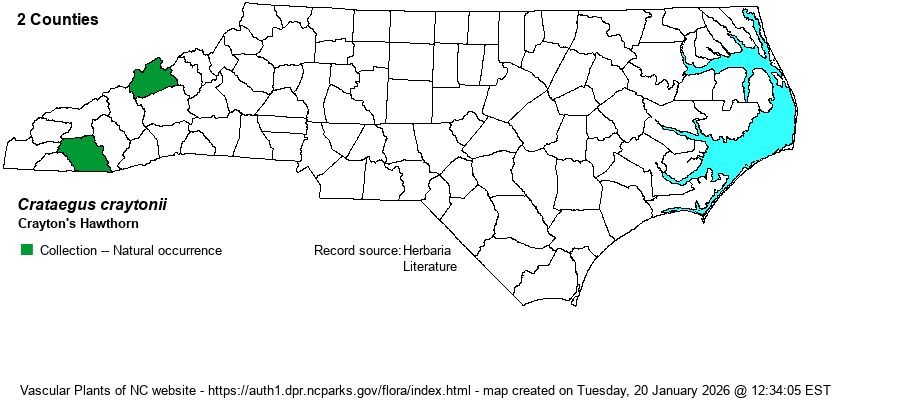| Author | Beadle | |
| Distribution | Apparently known only from the French Broad River near Marshall in Madison County and along the Cullasaja River near Highlands (Macon County). According to Lance (2014), this is its entire range, and it is endemic to NC.
This is one of the most poorly known Crataegus species in the NC region. Weakley (2018) states: “W. NC to n. GA, n. AL, possibly e. TN; an ambiguous record in New Kent County, VA.” On the other hand, Lance (2014) considers the species endemic to NC. | |
| Abundance | Presumably very rare in NC, with known records, based on Lance (2014), from two counties. This species likely should be listed by the NC NHP as a rare species; it is not currently in their database. Based on records from just two locations, so far, this website has assigned a state rank of S1?. As with many other Crataegus species, NatureServe has not yet considered this taxon as a good species, as its global rank is GNA. If Lance (2014) is correct in his assessment of this taxon, then it should be globally ranked as G1 or G1Q. | |
| Habitat | The NC sites appear to be from ravines and bluffs, along or close to rivers. Weakley (2018) mentions “roadsides”, as well, but it is not clear if any NC populations are along roadsides. |
| Phenology | Blooms in late April and May; fruits in September. | |
| Identification | This is a shrub, growing only to about 6-8 feet tall. The leaves are very widely ovate to nearly orbicular, nearly as wide as long, ranging to 2.5 inches long. The leaves are quite densely hairy on both surfaces as are the inflorescences; serrations are quite noticeable. The flowers have 20 stamens. The species is quite similar to C. intricata, a species that is not familiar by name to most biologists, either; both of these species were included within the former C. flabellata. | |
| Taxonomic Comments | Though described as early as 1902 – as were most hawthorns – this taxon somewhat disappeared from the scene, and was not included within C. flabellata in RAB (1968). However, Lance (2014) resurrected the taxon as a species in his book, though NatureServe does not yet have this and some other Crataegus taxa in their database.
| |
| Other Common Name(s) | Crayton Hawthorn. Both Lance (2014) and Weakley (2018) use the name without the apostrophe, whereas the Flora of Virginia website and book do. As the species is named after F. M. Crayton, most common names coined for a person traditionally use the apostrophe – such as in Britton’s Hawthorn, Buckley’s Hawthorn, and Gattinger’s Hawthorn. | |
| State Rank | [S1?] | |
| Global Rank | GNA | |
| State Status | [W7] | |
| US Status | | |
| USACE-agcp | | |
| USACE-emp | | |

